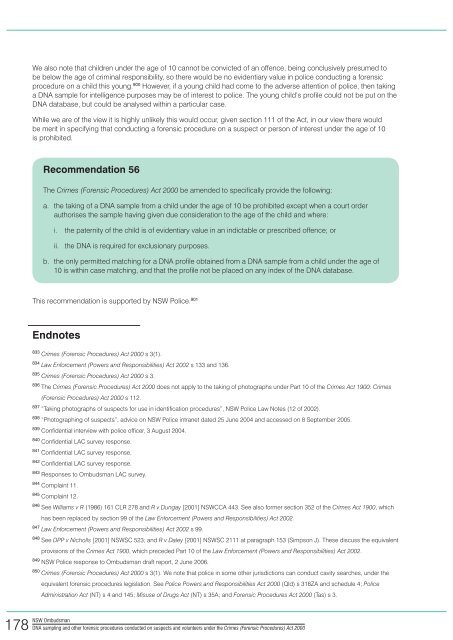Crimes (Forensic Procedures) Act 2000 - NSW Ombudsman - NSW ...
Crimes (Forensic Procedures) Act 2000 - NSW Ombudsman - NSW ...
Crimes (Forensic Procedures) Act 2000 - NSW Ombudsman - NSW ...
Create successful ePaper yourself
Turn your PDF publications into a flip-book with our unique Google optimized e-Paper software.
We also note that children under the age of 10 cannot be convicted of an offence, being conclusively presumed to<br />
be below the age of criminal responsibility, so there would be no evidentiary value in police conducting a forensic<br />
procedure on a child this young. 900 However, if a young child had come to the adverse attention of police, then taking<br />
a DNA sample for intelligence purposes may be of interest to police. The young child’s profile could not be put on the<br />
DNA database, but could be analysed within a particular case.<br />
While we are of the view it is highly unlikely this would occur, given section 111 of the <strong>Act</strong>, in our view there would<br />
be merit in specifying that conducting a forensic procedure on a suspect or person of interest under the age of 10<br />
is prohibited.<br />
Recommendation 56<br />
The <strong>Crimes</strong> (<strong>Forensic</strong> <strong>Procedures</strong>) <strong>Act</strong> <strong>2000</strong> be amended to specifically provide the following:<br />
a. the taking of a DNA sample from a child under the age of 10 be prohibited except when a court order<br />
authorises the sample having given due consideration to the age of the child and where:<br />
i. the paternity of the child is of evidentiary value in an indictable or prescribed offence; or<br />
ii. the DNA is required for exclusionary purposes.<br />
b. the only permitted matching for a DNA profile obtained from a DNA sample from a child under the age of<br />
10 is within case matching, and that the profile not be placed on any index of the DNA database.<br />
This recommendation is supported by <strong>NSW</strong> Police. 901<br />
Endnotes<br />
833 <strong>Crimes</strong> (<strong>Forensic</strong> <strong>Procedures</strong>) <strong>Act</strong> <strong>2000</strong> s 3(1).<br />
834 Law Enforcement (Powers and Responsibilities) <strong>Act</strong> 2002 s 133 and 136.<br />
835 <strong>Crimes</strong> (<strong>Forensic</strong> <strong>Procedures</strong>) <strong>Act</strong> <strong>2000</strong> s 3.<br />
836 The <strong>Crimes</strong> (<strong>Forensic</strong> <strong>Procedures</strong>) <strong>Act</strong> <strong>2000</strong> does not apply to the taking of photographs under Part 10 of the <strong>Crimes</strong> <strong>Act</strong> 1900: <strong>Crimes</strong><br />
(<strong>Forensic</strong> <strong>Procedures</strong>) <strong>Act</strong> <strong>2000</strong> s 112.<br />
837 “Taking photographs of suspects for use in identification procedures”, <strong>NSW</strong> Police Law Notes (12 of 2002).<br />
838 “Photographing of suspects”, advice on <strong>NSW</strong> Police intranet dated 25 June 2004 and accessed on 8 September 2005.<br />
839 Confidential interview with police officer, 3 August 2004.<br />
840 Confidential LAC survey response.<br />
841 Confidential LAC survey response.<br />
842 Confidential LAC survey response.<br />
843 Responses to <strong>Ombudsman</strong> LAC survey.<br />
844 Complaint 11.<br />
845 Complaint 12.<br />
846 See Williams v R (1986) 161 CLR 278 and R v Dungay [2001] <strong>NSW</strong>CCA 443. See also former section 352 of the <strong>Crimes</strong> <strong>Act</strong> 1900, which<br />
has been replaced by section 99 of the Law Enforcement (Powers and Responsibilities) <strong>Act</strong> 2002.<br />
847 Law Enforcement (Powers and Responsibilities) <strong>Act</strong> 2002 s 99.<br />
848 See DPP v Nicholls [2001] <strong>NSW</strong>SC 523; and R v Daley [2001] <strong>NSW</strong>SC 2111 at paragraph 153 (Simpson J). These discuss the equivalent<br />
provisions of the <strong>Crimes</strong> <strong>Act</strong> 1900, which preceded Part 10 of the Law Enforcement (Powers and Responsibilities) <strong>Act</strong> 2002.<br />
849 <strong>NSW</strong> Police response to <strong>Ombudsman</strong> draft report, 2 June 2006.<br />
850 <strong>Crimes</strong> (<strong>Forensic</strong> <strong>Procedures</strong>) <strong>Act</strong> <strong>2000</strong> s 3(1). We note that police in some other jurisdictions can conduct cavity searches, under the<br />
equivalent forensic procedures legislation. See Police Powers and Responsibilities <strong>Act</strong> <strong>2000</strong> (Qld) s 318ZA and schedule 4; Police<br />
Administration <strong>Act</strong> (NT) s 4 and 145; Misuse of Drugs <strong>Act</strong> (NT) s 35A; and <strong>Forensic</strong> <strong>Procedures</strong> <strong>Act</strong> <strong>2000</strong> (Tas) s 3.<br />
178<br />
<strong>NSW</strong> <strong>Ombudsman</strong><br />
DNA sampling and other forensic procedures conducted on suspects and volunteers under the <strong>Crimes</strong> (<strong>Forensic</strong> <strong>Procedures</strong>) <strong>Act</strong> <strong>2000</strong>

















